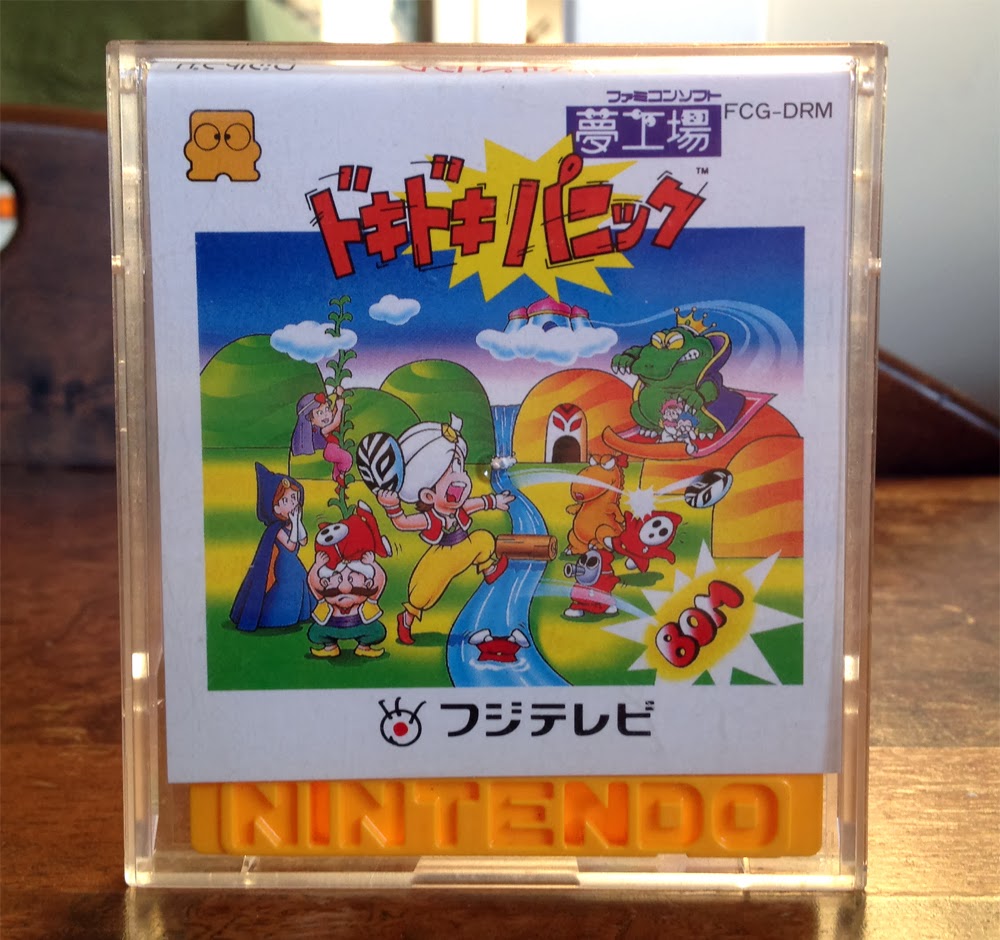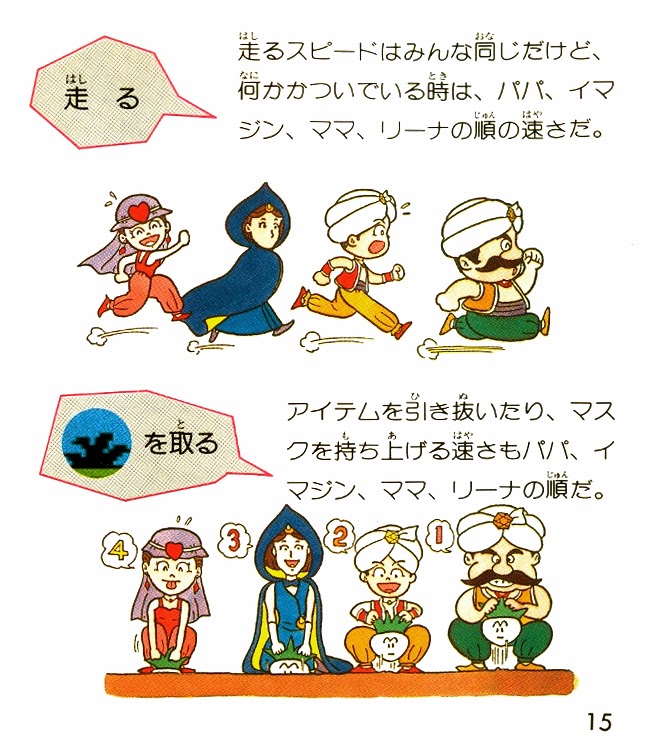You’re going to see a lot of them in this post.
I recently did something I’d only done once before in my life: sent away for a Japanese video game. Last time was years ago, and I did it to play a sequel to a beloved game that never made it outside Japan. This time, however, I bought a video game cartridge that I’ll probably never play.
It’s Doki Doki Panic, the game that became Super Mario Bros. 2, meaning that it’s for the Japanese version of the NES and that I therefore have no system to plug it into. I’m actually not sure why I even bought it, other than to possess a thing that always seemed out-of-reach. I can say this much, though: Flipping through the instruction manual makes for a very “red universe-blue universe” moment, because it means seeing familiar elements in a context that feels inherently wrong. It’s like someone mucked with the timeline and re-wrote history.
Here, you can play along too.
The official box art, for example, features the heroes, a jolly Arabian family, fighting the big bad and his monsters. It should look familiar even if you’d never heard of Doki Doki Panic, first because the big bad, Mamu, became Wart for the game’s transformation into Super Mario Bros. 2 and second because the box art for the Super Mario version of the game re-creates this scene, almost pose for pose.(Note, though, the latter is the artwork for Super Mario USA, the version of the American take on the game that Nintendo eventually released in Japan. The American box art for Super Mario Bros. 2 looks different, of course.)
Unsure what’s going on here, exactly, but I’ll say this much: My childhood could have benefitted from more anthropomorphic video game cartridges giving me instructions.
Something else I could have benefitted from in my childhood? Video games that devoted four pages of the instruction manual to storylines. It’s pretty clear that Mamu is trying to get a taste of those delicious winged moppets that Arabian culture is so famous for. I know what’s going on, more or less, and I know that the storybook motif explains why the final world is missing a level — I’ll bet it’s the ripped page in the bottom corner of page 8 — but if anyone can provide a word-for-word translation, I’d be eternally grateful.
I like how they show you the Bad Dream Machine right there in the manual, on the bottom of page 6, so as to prevent the “What the hell is that supposed be?” reaction I had when I got to the last room of the game back in the day.
I like how they show you the Bad Dream Machine right there in the manual, on the bottom of page 6, so as to prevent the “What the hell is that supposed be?” reaction I had when I got to the last room of the game back in the day.
I’ve mentioned before here that the pet monkey is not playable in the game, and I will point out a second time how that seems like a terrible oversight on Nintendo’s part. That said, they have dressed the monkey well.
Hit the jump for more.
Hit the jump for more.

Here, the “Mario” of the game, Imajin, admonishes you for something. I know not what.
Walkin’ toward each other, like you do. Again, I know not why.
Here, you learn about the various characters’ special abilities. Only you don’t need to, because they’re the same abilities as the Mario 2 cast. It’s interesting how these characters are now all but forgotten, yet they’re the reason certain Mario elements exist today. For example, Lina and Mama run more slowly than Imajin and Papa, but they compensate with superior jumping abilities. Those same jumping abilities are still around today, so it’s actually Lina and Mama who are responsible for Peach hovering in middair and Luigi jumping especially high in Super Mario 3D World.
It’s also worth pointing out that the Super Mario Bros. 2 instruction manual re-created these images too, but I suppose it’s just the most sensible way to convey this info graphically.
I can’t seem to find a good, large version of the vegetable-plucking line-up, but it was there in the manual too, and it even got re-created in the in-game intro to Super Mario Advance.
(Yes, it does in fact look like twerking, now that you see it in GIF form.)
Such a happy family, even despite the abduction of their children! I actually had a conversation on Twitter about Doki Doki Panic being rare in that it lets you play as all the members of a family: the mom, the dad and the kids. It was suggested that I write up something on such video games, but I actually got stuck after thinking of only one other: Legacy of the Wizard. I wonder if there are any more.
Again, more of Imajin where we’re used to seeing Mario. Everything else is basically unchanged, save for those weird masks on the bottom of page 20, which became mushroom blocks in Super Mario Bros. 2. (And if you’re curious about the abundance of masks in Mario 2, see this post.)
An overview of items. Again, it’s more or less the same, with a few obvious substitutions like the inexplicable racist blackface head getting switched out for a Koopa Troopa shell. Curious how Doki Doki Panic still has a star to grant you invincibility, Super Mario-style, when it wasn’t intended as a Mario game.
Yep, the extra life-granting slot machine got its start in Doki Doki Panic too, so I guess you could say that’s where the Super Mario 3D World version comes from. (The music is a dead give-away.)
A little weirdness here: Apparently Doki Doki Panic treats the gray Shy Guys as a separate enemy, while the American version doesn’t. I’m wracking my brain to remember if the gray ones acted any differently. Anyone? (Also, a little trivia: They only put one red Snifit in either version of game, even though he appears on both box arts.)
Only one “red world” moment, and it’s the less demonic-looking Phanto mask. (I prefer mine as frightening as possible.) But there are two other oddities here that might be explained by the images coming from a beta version of the game: the background behind that Beezo and whatever platform the Bob-Omb is walking on, which doesn’t appear in Super Mario Bros. 2.
Only one bit here: While they kept the original artwork for every other enemy, Nintendo re-drew Pokey the Amblin’ Cactus for the Super Mario Bros. 2 manual to look cuter but less like how he looks in-game. (See?) I just imagine some art director declaring, “It’s all good but this shitty-looking cactus has got to go.”
Both the American and Japanese versions of the game make the weird decision to show art of big bad but not a screenshot of how he actually looks in the game, even though he looks basically exactly like the art depicts. It would have been more surprising if you got to the last stage and the big bad had, like, blonde pigtails and a pink sundress. And yeah — no Clawgrip (or even Clawglip) here, as he’s unique to Mario 2.
Also, might any of you Japanese-savvy readers be able to translate page 37? I know it has something to do with this phone card featuring Imajin and Lina next to Mario and Peach.
Another odd tie between this game and the Mario games before Nintendo turned it into a Mario game. “Greetings, Arabian kids from an unrelated game. We are going to blink you out of existence shortly!”
Also, might any of you Japanese-savvy readers be able to translate page 37? I know it has something to do with this phone card featuring Imajin and Lina next to Mario and Peach.
Another odd tie between this game and the Mario games before Nintendo turned it into a Mario game. “Greetings, Arabian kids from an unrelated game. We are going to blink you out of existence shortly!”
More life lessons from an anthropomorphic video game cartridge. The life lesson you’re getting here is not to be a dick, I guess. The “don’t touch the magnetic strip” part seems especially invasive.
And that’s it.
Is it weird to feel nostalgic for something you didn’t actually experience? That’s the feeling I got flipping through this manual. Short of going back in time and playing it as a kid, I think I’ve gotten about as much as I can from this footnote in video game history. I don’t know if anyone else has gotten as much from it as I have. I think it was learning about the existence of Doki Doki Panic and how it had been retroactively absorbed into the Mario series that sparked an interest in “continuity immigrants,” as the aptly named Jor-Ellis Island refers to them. I’m also pretty sure that Doki Doki Panic is responsible for my love of overlooked, underappreciated and otherwise forgotten video games from this time period.
Maybe more than anything else, however, what really pings my “back in the day”-dar is the artwork. I don’t know who did the illustrations for Doki Doki Panic, but they nailed that “classic Nintendo” look. Should Nintendo ever release a collection of all this hand-drawn instruction booklet artwork one day, I know of at least one nerd who’d be happy to own it.
This? This is my childhood right here, even if this was a game I never played:
And another:
And another:
And finally, befitting his sad fate of getting wiped out of existence by an Italian plumber, we’ll close on Imajin getting electrocuted.
Video games, previously:

























No comments:
Post a Comment